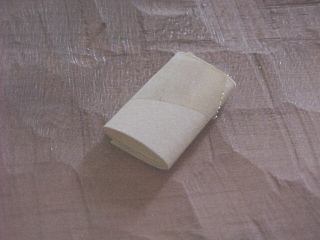Lesson #26: Protecting the paper from 'sagging'.
(contributed by Dave Bull)
The general 'rule' to follow when carving away the waste wood around an area that is being left in relief, is to remove all the wood out to a distance of 'yubi sanbon' (three fingers laid side-by-side). I guess in real language, that works out to about 4~5 centimeters.
Occasionally though, if the relief areas are spaced at around 10 centimetres apart, this means that the excavated areas that surround each relief area run into each other, and a fairly wide 'empty' space is thus created. During the printing process, if the paper is quite moist, and/or quite thin, it may sag into this space and pick up blotches of pigment.
One common device that printers here in Japan use to avoid such soiling of the print, is the use of a small roll of paper taped to the block right in the middle of the empty area. If this roll is placed so that its 'top' is just at the level of the relief areas, it will act as a support for the paper.

Why a roll of paper, instead of simply leaving an uncarved 'island' of wood there? Because this little roll is soft and flexible, and thus when the baren unavoidably moves over it during printing, it does not leave an impressed mark on the paper, as a wooden island does.
If the top of the roll becomes accidentally soiled by the brushing process, it is just a moment's work to roll up and tape a new one in place ...
